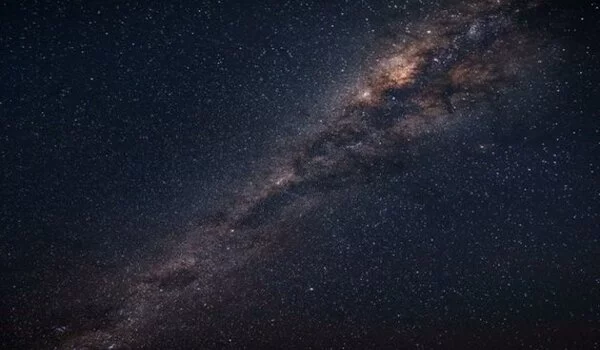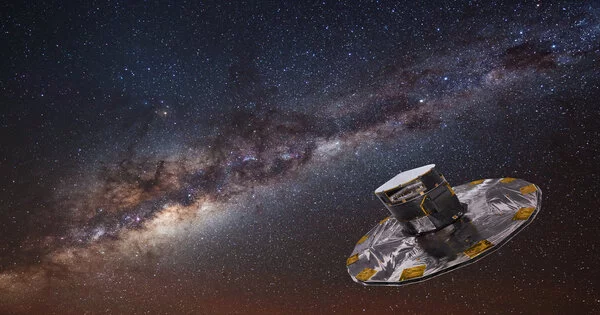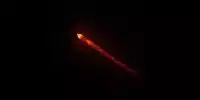The European Gaia space mission has generated an unprecedented amount of new, improved, and detailed data for nearly two billion objects in the Milky Way galaxy and its surroundings.
The European Space Agency’s Gaia space mission is constructing an ultraprecise three-dimensional map of our Milky Way galaxy by observing nearly two billion stars, or roughly one percent of all the stars in our galaxy. Gaia was launched in December 2013 and has been gathering scientific data since July 2014. ESA released Gaia data in Data Release 3. The release was heavily influenced by Finnish researchers.
Gaia data, for example, enables the calculation of asteroid and exoplanet orbits and physical properties. The data contributes to understanding the origin and future evolution of the solar system and the Milky Way, as well as stellar and planetary-system evolution and our place in the cosmos.
Gaia revolves slowly around its axis in about six hours and is made up of two optical space telescopes. Three scientific instruments allow for precise determination of stellar positions and velocities, as well as spectral properties. Gaia is located about 1.5 million kilometers from the Earth in the anti-Sun direction, where it orbits the Sun alongside the Earth near the so-called Sun-Earth Lagrange L2-point.
There have been so many revolutionary advances that it is difficult to single out one that is the most significant. Based on Gaia DR3, Finnish researchers will alter our understanding of asteroids in our Solar System, exoplanets and stars in our Milky Way galaxy, and galaxies in general, including the Milky Way and its satellite galaxies.
Gaia DR3 on June 13, 2022 was significant across astronomy. Some 50 scientific articles are being published with DR3, of which nine articles have been devoted to underscoring the exceptionally significant potential of DR3 for future research.
Chemical compositions, temperatures, colors, masses, brightnesses, ages, and radial velocities of stars are among the new DR3 data. DR3 contains the Milky Way’s largest binary star catalog, over 150 000 Solar System objects, mostly asteroids but also planetary satellites, and millions of galaxies and quasars beyond the Milky Way.
“There have been so many revolutionary advances that it is difficult to single out one that is the most significant.” Based on Gaia DR3, Finnish researchers will alter our understanding of asteroids in our Solar System, exoplanets and stars in our Milky Way galaxy, and galaxies in general, including the Milky Way and its satellite galaxies. Returning to our home planet, Gaia will produce an ultraprecise reference frame for navigation and positioning,” says Academy Professor Karri Muinonen from the University of Helsinki.
Gaia and asteroids
The ten-fold increase in the number of asteroids reported in Gaia DR3 as compared to DR2 means that there is a significant increase in the number of close encounters between Gaia-detected asteroids. These close encounters can be utilized for asteroid mass estimation and we expect a significant increase in the number of asteroid masses to be derived by using Gaia DR3 astrometry, in particular, when combined with astrometry obtained by other telescopes.
The asteroid is assumed to be a point-like object in conventional orbit computation, and its size, shape, rotation, and surface light scattering properties are not taken into account. The angular offset between the asteroid’s center of mass and the center of the area illuminated by the Sun and visible to Gaia must, however, be accounted for in the Gaia DR3 astrometry. The offset for asteroid (21) Lutetia has been certified using Gaia DR3. During a flyby on July 10, 2010, the ESA Rosetta space mission photographed Lutetia.

A rotation period, rotational pole orientation, and detailed shape model were derived using Rosetta Lutetia imagery and ground-based astronomical observations. When physical modeling is used in orbit computation, systematic errors are eliminated, and all observations, unlike in conventional computation, can be incorporated into the orbit solution. As a result, Gaia astrometry provides data on the physical properties of asteroids. These properties must be considered when developing physical models or empirical error models for astrometry.
For the first time, spectral observations are included in the Gaia DR3. The spectrum measures the target’s color, or brightness at different wavelengths. One particularly intriguing feature is that the new release includes approximately 60 000 spectra of asteroids in our Solar System. The asteroid spectrum contains information about their composition, as well as their origin and the evolution of the entire Solar System. There were only a few thousand asteroid spectra available prior to the Gaia DR3, so Gaia will multiply the amount of data by more than an order of magnitude.
Gaia and exoplanets
Gaia is expected to discover up to 20,000 giant exoplanets by measuring their gravitational influence on the movement of their host stars. This will allow for the discovery of nearly all Jupiter-like exoplanets in the Solar neighbourhood in the coming years, as well as determining how common Solar System-like architectures are. The first astrometric Gaia detection was a giant exoplanet orbiting epsilon Indi A, which corresponds to the closest Jupiter-like exoplanet only 12 light years away. The first such detections are possible because radial velocity survey acceleration can be combined with Gaia movement data to determine orbits and planetary masses.
Gaia and galaxies
Gaia DR3’s microarcsecond resolution allows for precise measurements of star motions not only within our own Milky Way galaxy, but also in the many satellite galaxies that surround it. We can accurately measure the mass of the Milky Way from the motion of stars within it, and we can now accurately determine satellite orbits from the proper motion of satellites. This allows us to see both the past and the future of the Milky Way galaxy system. For example, we can determine which of the galaxies that orbit the Milky Way are true satellites and which are simply passing through. We can also investigate if the evolution of the Milky Way conforms to cosmological models, and in particular, whether the satellite orbits fit the standard dark matter model.
Gaia and reference frames
The position of a few thousand quasars determined by Very Long Baseline Interferometry (VLBI) at radio wavelengths is the basis for the International Celestial Reference Frame, ICRF3. ICRF3 is used to calculate the coordinates of celestial objects and satellite orbits. ICRF3 quasars are also fixed points in space that can be used to determine the precise orientation of the Earth in space at any time. Satellite positioning, for example, would not function without this information.
Gaia’s data contains approximately 1.6 million quasars that can be used to create a more accurate Celestial Reference Frame in visible light to replace the current one. In the future, this will have an impact on the accuracy of both satellite positioning and measurements of Earth-exploring satellites.
















